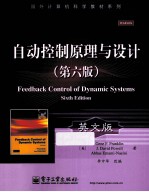
- 作 者:(美)富兰克林著
- 出 版 社:北京:电子工业出版社
- 出版年份:2013
- ISBN:9787121191022
- 标注页数:590 页
- PDF页数:606 页
请阅读订购服务说明与试读!
订购服务说明
1、本站所有的书默认都是PDF格式,该格式图书只能阅读和打印,不能再次编辑。
2、除分上下册或者多册的情况下,一般PDF页数一定要大于标注页数才建议下单购买。【本资源606 ≥590页】
图书下载及付费说明
1、所有的电子图书为PDF格式,支持电脑、手机、平板等各类电子设备阅读;可以任意拷贝文件到不同的阅读设备里进行阅读。
2、电子图书在提交订单后一般半小时内处理完成,最晚48小时内处理完成。(非工作日购买会延迟)
3、所有的电子图书都是原书直接扫描方式制作而成。
Chapter 1 An Overview and Brief History of Feedback Control 1
A Perspective on Feedback Control 1
Chapter Overview 2
1.1 A Simple Feedback System 3
1.2 A First Analysis of Feedback 6
1.3 A Brief History 9
1.4 An Overview of the Book 14
Problems 16
Chapter 2 Dynamic Response 19
A Perspective on System Response 19
Chapter Overview 20
2.1 Review of Laplace Transforms 20
2.1.1 Response by Convolufion 20
2.1.2 Transfer Functions and Frequency Response 25
2.1.3 The L_Laplace Transform 32
2.1.4 Properties of Laplace Transforms 34
2.1.5 Inverse Laplace Transform by Partial-Fraction Expansion 36
2.1.6 The Final Value Theorem 38
2.1.7 Using Laplace Transforms to Solve Problems 39
2.1.8 Poles and Zeros 41
2.1.9 Linear System Analysis Using MATLAB 42
2.2 System Modeling Diagrams 48
2.2.1 The Block Diagram 48
2.2.2 Block Diagram Reduction Using MATLAB 53
2.3 Effect of Pole Locations 54
2.4 Time-Domain Specifications 62
2.4.1 Rise Time 62
2.4.2 Overshoot and Peak Time 63
2.4.3 Settling Time 64
2.5 Effects of Zeros and Additional Poles 66
2.6 Stability 76
2.6.1 Bounded Input-Bounded Output Stability 76
2.6.2 Stability of LTI Systems 77
2.6.3 Routh's Stability Criterion 78
2.7 Historical Perspective 87
Problems 89
Chapter 3 A First Analysis of Feedback 108
A Perspective on the Analysis of Feedback 108
Chapter Overview 109
3.1 The Basic Equations of Control 109
3.1.1 Stability 111
3.1.2 Tracking 112
3.1.3 Regulation 112
3.1.4 Sensitivity 113
3.2 Control of Steady-State Error to Polynomial Inputs:System Type 116
3.2.1 System Type for Tracking 117
3.2.2 System Type for Regulation and Disturbance Rejection 121
3.3 The Three-Term Controller:PID Control 124
3.3.1 Proportional Control(P) 125
3.3.2 Proportional Plus Integral Control(PI) 125
3.3.3 PID Control 126
3.3.4 Ziegler-Nichols Tuning of the PID Controller 130
3.4 Introduction to Digital Control 136
3.5 Historical Perspective 141
Problems 145
Chapter 4 The Root-Locus Design Method 158
A Perspective on the Root-Locus Design Method 158
Chapter Overview 159
4.1 Root Locus of a Basic Feedback System 159
4.2 Guidelines for Determining a Root Locus 164
4.2.1 Rules for Plotting a Positive(180°)Root Locus 166
4.2.2 Summary of the Rules for Determining a Root Locus 171
4.2.3 Selecting the Parameter Value 172
4.3 Selected Illustrative Root Loci 174
4.4 Design Using Dynamic Compensation 186
4.4.1 Design Using Lead Compensation 187
4.4.2 Design Using Lag Compensation 192
4.4.3 Design Using Notch Compensation 193
4.4.4 Analog and Digital Implementations 195
4.5 A Design Example Using the Root Locus 198
4.6 Extensions of the Root-Locus Method 204
4.6.1 Rules for Plotting a Negative(0°)Root Locus 205
4.7 Historical Perspective 208
Problems 212
Chapter 5 The Frequency-Response Design Method 228
A Perspective on the Frequency-Response Design Method 228
Chapter Overview 229
5.1 Frequency Response 229
5.1.1 Bode Plot Techniques 236
5.1.2 Steady-State Errors 247
5.2 Neutral Stability 249
5.3 The Nyquist Stability Criterion 251
5.3.1 The Argument Principle 252
5.3.2 Application to Control Design 253
5.4 Stability Margins 266
5.5 Bode's Gain-Phase Relationship 273
5.6 Closed-Loop Frequency Response 278
5.7 Compensation 279
5.7.1 PD Compensation 280
5.7.2 Lead Compensation 280
5.7.3 PI Compensation 292
5.7.4 Lag Compensation 292
5.7.5 PID Compensation 297
5.7.6 Design Considerations 303
5.8 Historical Perspective 305
Problems 308
Chapter 6 State-Space Design 328
A Perspective on State-Space Design 328
Chapter Overview 328
6.1 Advantages of State-Space 329
6.2 System Description in State-Space 331
6.3 Block Diagrams and State-Space 338
6.3.1 Time and Amplitude Scaling in State-Space 340
6.4 Analysis of the State Equations 341
6.4.1 Block Diagrams and Canonical Forms 341
6.4.2 Dynamic Response from the State Equations 352
6.5 Control-Law Design for Full-State Feedback 358
6.5.1 Finding the Control Law 359
6.5.2 Introducing the Reference Input with Full-State Feedback 367
6.6 Selection of Pole Locations for Good Design 371
6.6.1 Dominant Second-Order Poles 372
6.6.2 Symmetric Root Locus(SRL) 373
6.6.3 Comments on the Methods 382
6.7 Estimator Design 382
6.7.1 Full-Order Estimators 382
6.7.2 Reduced-Order Estimators 388
6.7.3 Estimator Pole Selection 392
6.8 Compensator Design:Combined Control Law and Estimator 394
6.9 Introduction of the Reference Input with the Estimator 407
6.9.1 A General Structure for the Reference Input 408
6.9.2 Selecting the Gain 418
6.10 Integral Control and Robust Tracking 418
6.10.1 Integral Control 419
6.11 Historical Perspective 421
Problems 424
Chapter 7 Nonlinear Systems 444
Perspective on Nonlinear Systems 444
Chapter Overview 445
7.1 Introduction and Motivation:Why Study Nonlinear Systems? 445
7.2 Analysis by Linearization 447
7.2.1 Linearization by Small-Signal Analysis 448
7.2.2 Linearizafion by Nonlinear Feedback 453
7.2.3 Linearization by Inverse Nonlinearity 453
7.3 Equivalent Gain Analysis Using the Root Locus 454
7.3.1 Integrator Antiwindup 460
7.4 Equivalent Gain Analysis Using Frequency Response:Describing Functions 464
7.4.1 Stability Analysis Using Describing Functions 470
7.5 Historical Perspective 474
Problems 476
Chapter 8 Control System Design:Principles and Case Studies 483
A Perspective on Design Principles 483
Chapter Overview 484
8.1 An Outline of Control Systems Design 485
8.2 Design of a Satellite's Attitude Control 490
8.3 Lateral and Longitudinal Control of a Boeing 747 507
8.3.1 Yaw Damper 512
8.3.2 Altitude-Hold Autopilot 519
8.4 Control of the Fuel-Air Ratio in an Automotive Engine 525
8.5 Control of the Read/Write Head Assembly of a Hard Disk 532
8.6 Control of RTP Systems in Semiconductor Wafer Manufacturing 540
8.7 Chemotaxis or How E.Coli Swims Away from Trouble 554
8.8 Historical Perspective 562
Problems 566
Appendix Solutions to the Review Questions 579
